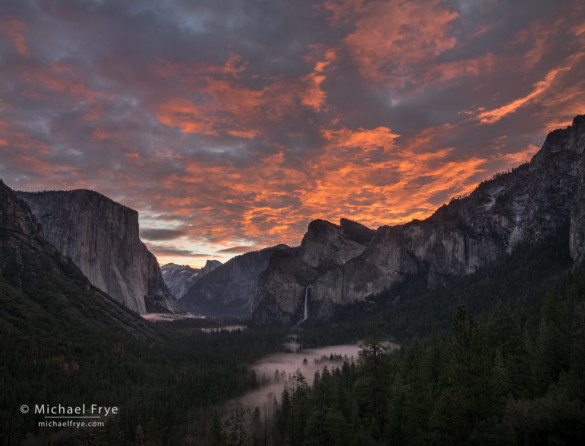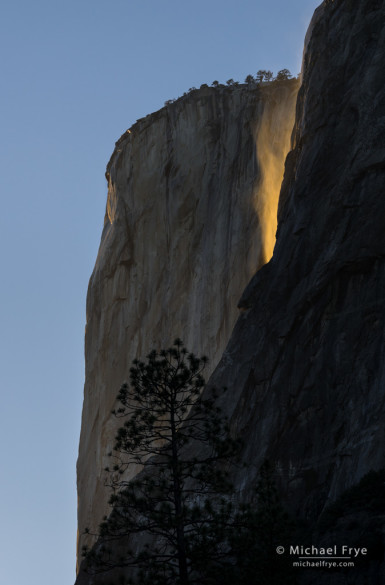Yosemite Valley got about three inches of rain from the storms over the weekend. That’s not a drought-busting amount, but it helps, and I’m grateful for every drop.
The first wave of rain arrived Friday night, and lingered through Saturday. Early Sunday morning I looked at the satellite and radar images online, and saw thin, high clouds moving in ahead of the next system. Thinking that those clouds might light up at sunrise, I made the trip up to Tunnel View. Soon after I got there a bit of color appeared behind Half Dome, and then within minutes the whole sky caught on fire. It turned into the most colorful sunrise I’ve ever seen from that spot; you can see a photograph above.
The second wave of rain arrived Sunday evening. It started slowly, but around 9:30 p.m. a band of heavy rain passed through Mariposa County and headed toward Yosemite. I was actually out driving during this squall, and had to stop and pull off the road four separate times because it was raining so hard I could only see about 20 feet ahead.
Judging by the webcams, it looked like a pretty sunrise Monday morning in Yosemite Valley. Unfortunately I couldn’t get there because the torrential rain caused a rockslide which closed the road! I made it up to the Valley in the afternoon after the road reopened, and found the waterfalls roaring. Yosemite Falls looked more like May than February.
And yes, Horsetail was flowing too. It was barely trickling Sunday morning, but yesterday afternoon it was flowing well, at about average levels for February. There was enough water and wind to blow spray around, and make it possible to photograph Horsetail from an angle behind the cliff, as you can see in the photograph below. Without the wind I couldn’t have even seen the waterfall from this spot.
Unfortunately, the temporary boost from rain runoff will diminish quickly. Horsetail’s tiny watershed consists mostly of sloping granite slabs, with a few trees and pockets of sandy soil. A downpour in that drainage runs off like a bucket of water on a tin roof. The only thing that provides a sustained water flow is melting snow, and there is hardly any snow in Horsetail’s drainage. These were warm storms, and snow levels were above 9,000 feet during most of the weekend, well above Horsetail’s watershed. At the tail end of the second storm temperatures dropped, and snow fell down to around 7,000 feet. Parts of Horsetail’s drainage probably got a few inches of snow, but that will melt quickly.
So although the window of best light for Horsetail Fall is around February 16th through 23rd (I explain why in this post), this year it might be better to go before that. You won’t get ideal lighting, but at least you’ll have water. With no more precipitation in the seven-day forecast, I suspect the flow will be down to a trickle again by the 16th.
The same goes for the other waterfalls too. Yosemite Falls is gushing now, but will also diminish over the next week (although more slowly than Horsetail). But for the next few days there’s an opportunity to photograph it with lots of water and winter light. For example, you can see a rainbow on the Upper Fall from the east end of Cook’s Meadow early in the morning from the very eastern end of Cook’s Meadow, or catch low-angle morning sidelight on the falls from Swinging Bridge. (Of course you can find information about those locations, and the best spots to photograph Horsetail Fall, in my Photographer’s Guide to Yosemite book and app.)
I hope I’m wrong about Horsetail, and the flow lasts a couple of weeks. Or maybe we’ll get some more not-yet-forecast precipitation. We’ll see!
— Michael Frye
Related Posts: The Best Time to Photograph Horsetail Fall, Revised; Will the Approaching Storm Revive Horsetail Fall?
Did you like this article? Click here to subscribe to this blog and get every new post delivered right to your inbox!
Michael Frye is a professional photographer specializing in landscapes and nature. He is the author or principal photographer of The Photographer’s Guide to Yosemite, Yosemite Meditations, Yosemite Meditations for Women, Yosemite Meditations for Adventurers, and Digital Landscape Photography: In the Footsteps of Ansel Adams and the Great Masters. He has also written three eBooks: Light & Land: Landscapes in the Digital Darkroom, Exposure for Outdoor Photography, and Landscapes in Lightroom 5: The Essential Step-by-Step Guide. Michael has written numerous magazine articles on the art and technique of photography, and his images have been published in over thirty countries around the world. Michael has lived either in or near Yosemite National Park since 1983, currently residing just outside the park in Mariposa, California.











Beautiful… Capturing such light and landscape. Hope for rain 🙂
Thanks Randall!
That’s beautiful Michael. I love seeing a good flow in Bridalveil and I like the mini fog banks.
Thanks John, and it was nice to see a good flow in Bridalveil. The flow was even higher yesterday.
Absolutely stunning. You are my absolute favorite Yosemite photographer. Thank you for bringing these beautiful images to us. 🙂
Thanks Virginia!
Thanks for the info, Michael! Maybe I’ll get up there in a couple of days. As you point out, there are other scenes besides Horsetail.
You’re welcome Jim, and good luck!
Now that really is one out of the box, Michael. Magnificent! You deserve to make a lot of money from this one! 🙂
Thanks Geoff!
I’m seeing reports that the NPS is doing some controlled burns in Yosemite during this dry period. Does it look like the particulates are having much impact on the afternoon/evening skies or sunsets? Thanks for being such a great resource for us, Michael–our anticipation levels are on the rise!!!
Jim, I haven’t heard or seen anything about controlled burns recently. There wasn’t any smoke in the valley on Sunday or Monday. That doesn’t mean they couldn’t start a burn at any time, but again, I haven’t heard anything.
Thanks, Michael…
That first shot is just breath taking! I’m hoping more precipitation comes your way.
Thanks Vivienne, and me too!
Thanks for the Horsetail update, Mike. Much appreciated. Heading up Friday.
You’re welcome David, and good luck!
Gorgeous sunrise scene. Demands a BIG print! 🙂
Thanks Chuck!
Hi Michael,
Have you done a blog post on how you use weather forecasts? It would be great to learn what websites you use and how you interpret what you see on weather satellite and radar images.
Beautiful photo at the top of this post. The bit of fog in the valley really adds to the drama of the sky. It must have been wonderful to be there and experience that sunrise.
Greg, I’ve thought about this, but it gets pretty complex, and it’s more art than science. I mostly just use the NOAA website, and their visible and infrared satellite images. I also use Intellicast because I like their radar imagery. Glad you like the photo!
Michael,
Do you think it will be good to go up this weekend?
Kevin, if you’re talking about Horsetail Fall, that’s iffy. I haven’t been up there since Monday, but as I said here, I think the flow will drop pretty quickly in Horsetail. Maybe someone reading this has been up there more recently and can comment.
Thanks for the post, Michael. Great sunrise image and the Horsetail Fall image is also very cool.
Thanks very much Robin!